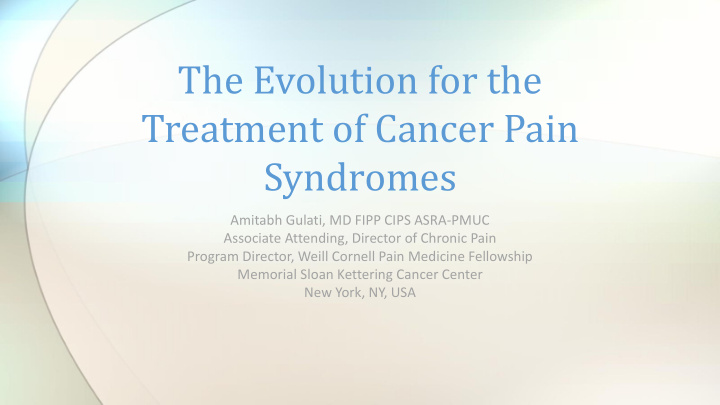



The Evolution for the Treatment of Cancer Pain Syndromes Amitabh Gulati, MD FIPP CIPS ASRA-PMUC Associate Attending, Director of Chronic Pain Program Director, Weill Cornell Pain Medicine Fellowship Memorial Sloan Kettering Cancer Center New York, NY, USA
Financial Disclosures • Consultant for Medtronic, Flowonix, SPR Therapeutics, Nalu Medical, and Bausch Health • Advisor for AIS HealthCare
Outline • Brief introduction to primary cancer pain pathology • Treatment related pain syndromes • Chemotherapy and Immunotherapy • Radiation • Surgery • Models for pain treatment options – the role of ultrasound • An Ultrasound guided, Algorithmic Approach
Cancer Pain and Pharmacotherapy • Pain – physical compression • Nociceptive • Visceral (e.g. pancreatic CA back pain) • Musculoskeletal (e.g. bone CA/metastasis) • Neuropathic • lumbar plexopathy from a psoas mass • Neurologic tumors (schwannoma) de Leon-Casasola OA, Cancer Control. 2000 Mar-Apr;7(2):142-8
The cancer burden is changing - chronic cancer pain conditions • As of 2010 – • Overall incidences are decreasing (not breast CA) • Overall mortality improving • Now newer immunotherapies are available Cho H Nat Can Ins Mono 2014 Mariotto AB Nat Can Ins Mono 2014
Pathophysiology of primary cancer pain: Bone Disease and Monoclonal Antibodies • Myeloma Bone Disease • ↑Osteoclasts – cathespin mediated bone resorption • Decreased osteoblast activity • Targeted pain therapies • Nitrogen based bisphosphonates • Receptor targets • Proteosome inhibition-Bortezomib • RANKL antagonists-denosumab Hameed A Canc Gr and Met 2014
Treatment related syndromes
Chemotherapy induced peripheral neuropathy • A chemotherapy dose limiting toxicity • IV Ketamine treatments • DRG is a common target Kim JH Jo Gyn Onc 2015 Brewer JR Gyn Onc 2015
Immune checkpoint inhibitors • Antibodies to • CTLA-4 deactivate the inhibition signal of T-cells • PD-1 or PD-L1 activate anti- tumor response of T-cells • Have changed the course of end-stage melanoma, renal cell and lung carcinoma Spain L Cancer Treatment Reviews 2016
Radiation induced peripheral neuropathy • Vascular and fibrotic phases • Months to years after treatment (e.g. RIBP) • Incidence 2-3% per year • Decreased to 1-2% with <55Gy • Diagnosis of exclusion • Cancer recurrence • Schwannoma • Other neurologic disease states • Rx - Pentoxifyllin + tocopherol + clondronate? Delanian S Rad and Onc 2012
Post-thoracotomy Pain Syndrome • Predictive factors • Up to 50% incidence • Decreased in elderly • 3-18% severe pain • Increased in females • Majority is scar related • Surgical incision independent • Diffuse noxious inhibitory even with VATS vs open control thoracotomy • Likely injury to intercostal • Genetic variants of COMT and nerve Na channels • Surgical technique reducing nerve damage Wildgaard K Eur J of CT Surg 2009
Post-mastectomy pain syndrome • Incidence 20-50% • Complex neural pathways of • Intercostobrachial nerve • Associated poor quality of life • Intercostal nerves • Lateral and medial pectoralis • Constellation of syndromes nerves • Phantom breast pain • Thoracodorsal nerve • Intercostobrachial neuralgia • Long thoracic nerve • Neuroma and scar • Peripheral nerve injury (long • Muscular pain and scarring thoracic nerve etc) De Menezes Courceiro TC Rev Bras Anes 2009
Treatment paradigms
Biopsychosocial Model Novy DM Crnt opin support pall care 2014
Anatomical Approach • While addressing palliative and • Consider supportive care needs • Anatomic model • A treatment-based team • Discuss therapeutic options for acute cancer pain syndromes including • Oncologists • Biopsychosocial model • Interventional pain specialists • Reduce symptom burden during • Radiation oncologists the subacute phase • Surgeons • Treating chronic cancer pain syndromes • Typically neurosurgeons • Radiologists • Rehabilitation specialists
Why Revisit Anatomical Approaches?
The Introduction of Ultrasound • Intercostal cryoneurolysis under ultrasound guidance Byas-Smith M, Gulati A A&A 2006
Regional Anesthesia • Retrospective review • In training anesthesiologists • N = 14498 (all major RA • Observational study blocks) • PNS blocks N= 5436 • USG blocks N= 9062 • PNS • 6 LAST occurrences 1 nerve injury <12 mo. • USG • No reported occurrences • 4 nerve injury 3< 12 mo Orebaugh et al. RAPM 2009 and update 2012
Take for example intercostobrachial nerve • Paravertebral block • Field block
The Application of Ultrasound • 28 males • 1 mL of 2 % lidocaine Thallaj AK Saudi Med J 2015
Our approach to T2 paravertebral space
The Muscle Plane Piracha M RAPM 2017
Superficial serratus anterior plane • 16 pre op patients scanned for technique • 10mL 0.5% bupivacaine • 6 patients injected for lateral chest wall, axilla, or medial arm persistent pain Wijayasinghe N Pain Phys 2016
Our approach to the superficial SA plane Zocca J Pain Prac 2016
Ultrasound Guidance and Advanced Algorithms
Chest Wall Algorithm Gulati A Pain Med 2015
Our illustrative cases
Lumbosacral metastatic disease • Sacroiliac joint and ligaments • RFA of the joint injections Hutson N Pain Med 2017
Interesting Developments • Sacroiliac joint injections of the ligamentous part between S1 and S2 with PSL as secondary target • 2-3 injections over 3 months • Reduction of sacroplasty to almost nil.
Proximal joint injection for Sacral Fracture and Sacroiliac Metastasis Oh D Pain Practice 2020
Introduction of neuromodulation • Intrathecal drug delivery for advancing disease • Consider SCS trial for stable neuropathic pain Legler et al IPM Reports 2017
Thoracic Spinal Metastasis
Ultrasound guided thoracic targets Rakesh e al. Pain Prac 2019
Post-mastectomy pain • A complicated pain syndrome • Even since publication, we have changed our paradigms.
PMPS Algorithm 2020 N= 350 Yang A Pain Medicine (accepted in press)
Thank You • Please be safe everyone • Any questions, please email me at gulatia@mskcc.org
Recommend
More recommend